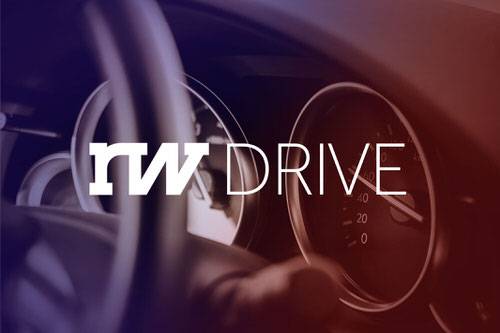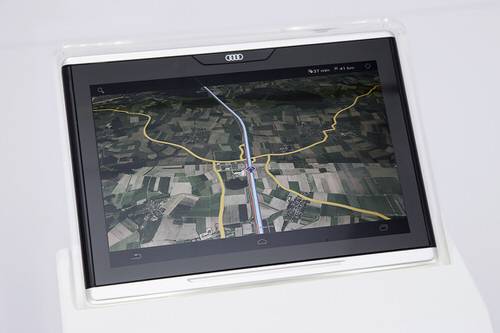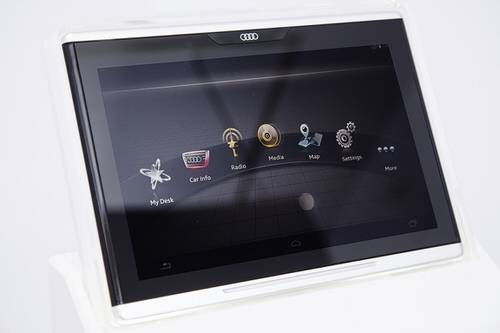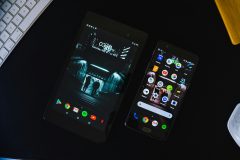
ReadWriteDrive is an ongoing series covering the future of transportation.
Silicon Valley companies grab headlines for their incursions into the auto industry, crossing industry lines to gain control of dashboards and drivetrains. In response, tech-savvy car companies will try to defend their turf—even when the development of their own hardware and software might raise a few eyebrows.
Audi is taking a bleeding edge approach, or at least what counts for one in the auto industry. Earlier this year, it announced intentions to develop its very own Audi-branded tablet. The device, a concept when announced at CES in January, is now green-lighted for production.
“It will be a full-blown Android tablet,” Brad Stertz, corporate communications manager for Audi of America, told me. The Audi Smart Display docks into the back of headrests for use by backseat passengers—a passenger-oriented extension of the “infotainment” systems automakers have been pushing into central consoles for the past few years. “This is not just theory,” said Stertz. “It’s headed to a future model. We haven’t said what year, but it will be coming.”

Stertz says the tablet’s arrival is four to five years away at the latest—essentially one product-planning cycle for the auto industry. The only problem: That’s more like four or five product cycles for the tech industry.
Cars and the Tablet Revolution
Why would a car company want to create a tablet that lives in the car, rather than just pairing with mobile devices carried by passengers? Audi says it’s about deeper integration.
Audi’s car-specific, high-resolution 10.2-inch tablet essentially functions like a detachable part of the vehicle’s controls. The driver doesn’t need to be bothered or distracted with some functions currently embedded into the dashboard. For example, with a car-based tablet, passengers can search for points of interest and then have the navigation system spit out turn-by-turn directions.
Similar features are already available in some versions of the top-of-the-line flagship Audi A8 sedan. In those models, the rear seat infotainment package has two permanently fixed 10-inch screens embedded in seat backs. The proposed dockable tablet, powered by Nvidia’s fast new Tegra 4 processor, simply adds more connectivity and portability.
Pace of Innovation
At first blush, the introduction of a vehicle-branded tablet has a wow effect. There’s no doubt that cars are becoming increasingly connected devices—an extension of our digital lives. However, once a car company jumps into the fast-paced high-stakes game of hardware development, there’s no turning back. What’s going to keep people from sneering at the museum pieces in Audi vehicles four years from now, particularly since they’ll be compared with mobile devices currently beyond our imagination?
“The company in Germany is looking into how to provide an upgrade, or a rebate, to turn in an old tablet to get a newer one,” said Audi’s Stertz. “That’s definitely something that’s on the horizon. We’re working to reduce the gap between consumer and automotive electronics and not stick people with old equipment.”
That’s critical, because the auto industry operates on three to five year product cycles. Audi, a luxury brand of Volkswagen, is keeping up better than most other companies. It announced in late 2013 that its 2015 A3 line of compact cars would be among the first to offer 4G LTE service. Those cars will become hotspots, allowing up to eight mobile devices to work with the car’s 4G LTE connection. But keep in mind that, by the time 4G is in the A3, the high-speed communication standard will have been generally available for about five years in the United States.
Future-proofing will be no easy task. Audi argues that the ability of its own car-based tablet to migrate back and forth from garage to living room has compelling advantages. You can plan a trip from the comfort of home—setting up destinations, RSS feeds, music playlists, and streaming movies. Then you can carry the tablet back to the car, dock it, and presto! Your commute or road trip is set.
But I can’t see how that’s fundamentally different from deploying those plans directly to the car’s connected system via the Web, or a paired phone or tablet, instead of physically walking the Audi tablet into the vehicle.
Stertz defends the tablet approach by saying that infotainment touch-screen functionality will be available to passengers via the car’s fixed hardware. The creation of dockable units is really no different, except that it adds portability.
Automotive Grade

Maybe the motivation to create a tablet is about control. Audi’s existing suite of connected services, called Audi Connect, already enables navigation, real-time traffic, fuel price and parking information. The proposed car-based tablet, as an Android device, will allow passengers to integrate nearly the million apps (Skype, calendars, and messaging, as well as games) available on Google Play into the Audi system, which serves as the broader platform.
Meanwhile, Audi has not ruled out out collaboration with Apple in order to allows iPhone and iPads to integrate with the dashboard. “But our system is further down the pipeline,” said Stertz. “We already have strong mapping with Google Earth. Nobody else has that. We have strong voice command, like Siri, but ours is run through Google Local Voice Search.”
Unlike conventional tablets, the Audi Smart Display is built to automotive standards for durability and reliability—much tougher guidelines than those governing common consumer electronics. The screen’s glass surface is crash-worthy. The dockable car tablet can safely remain in the car when it’s parked all day on the hottest day in Arizona, and stay docked all night in the car on the coldest Minnesota night.

















